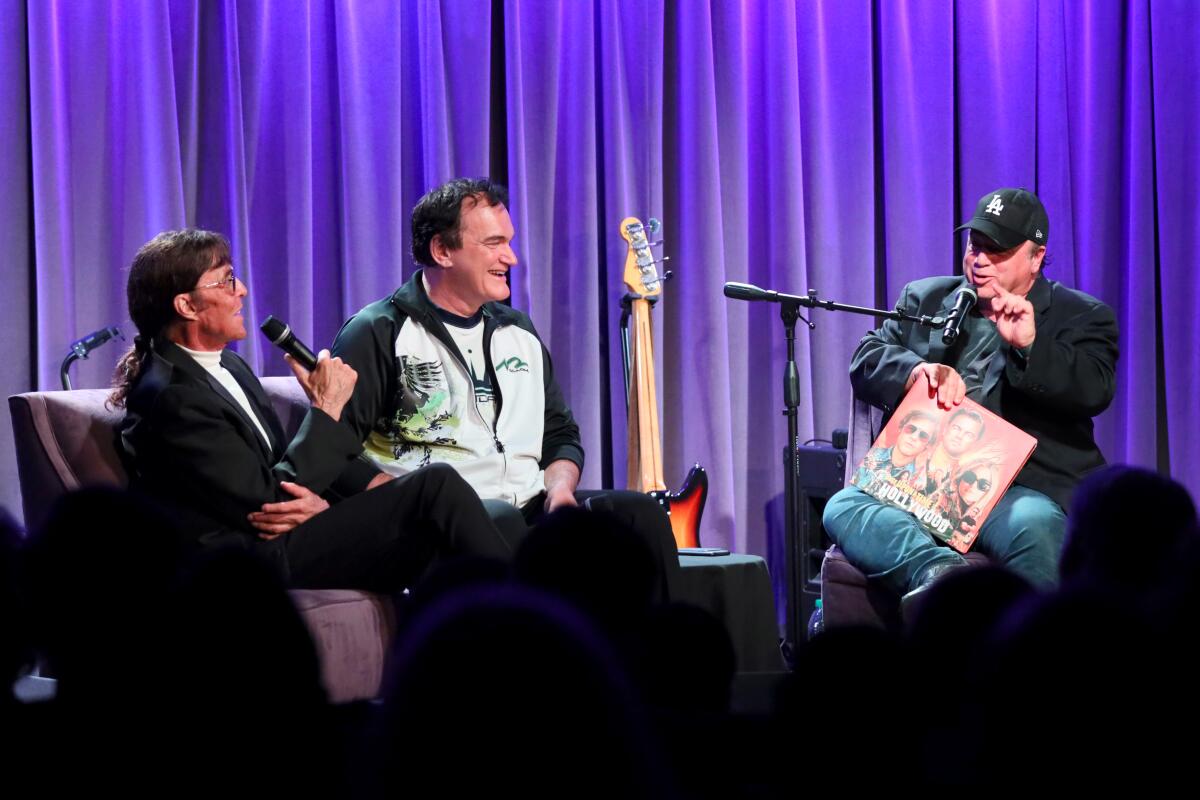How Quentin Tarantino got the ‘60s sound for ‘Once Upon a Time... in Hollywood’

- Share via
For a brief moment in his then-young rock career, Mark Lindsay lived in a gorgeous home at the top of Benedict Canyon. The singer-songwriter, co-founder of the group Paul Revere & the Raiders, moved there with his buddy, record producer Terry Melcher, in the late ’60s. He wrote some of his band’s best work there, including the single “Good Thing,” which he penned on a piano in the living room.
Lindsay left the house when Melcher wanted to live with his girlfriend, actress Candice Bergen. They soon rented the place to director Roman Polanski and his wife, Sharon Tate.
What happened next in that living room inaugurated one of the darkest weeks in L.A. history. But Lindsay still remembers the place fondly, even if he did once bump into Charles Manson at a party there.
“Those two years were my golden years,” Lindsay said onstage at the Grammy Museum on Wednesday night in conversation with director Quentin Tarantino. “I remember drinking rosè in the garden with Terry outside in that liquid sunshine and saying, ‘it doesn’t get better than this’ and thinking it’ll never get worse. It didn’t until 1969.”
For director and L.A. native Tarantino, however, the coincidence is a thread that ties his whole film “Once Upon a Time … In Hollywood” together. All of his obsessions — vintage rock and roll, movie-business lore, darkly comic idylls cut through with horrific violence — wound through that property at the top of Cielo Drive (it’s now demolished, of course). He and Lindsay talked about evoking that golden era of L.A. rock radio in “Once Upon a Time …” and how it set the tone for the nightmare to come.
“Paul Revere & the Raiders was exactly the kind of band that would have rocked my little socks off,” Tarantino said of Lindsay’s pre-fab conceptual, velvety-voiced act. “And the reason Manson knew of Terry Melcher was because of Paul Revere & the Raiders.”
“Once Upon a Time …” was the rare original summer flick to best $100 million at the box office this year. The star-packed throwback follows a TV actor (Leonardo DiCaprio) and his loyal stuntman sidekick (Brad Pitt) through the wane of their careers in late-’60s L.A., all while something evil kindles in the canyons over the hill.
Throughout the film, Lindsay’s songs help set the hyper-specific tone of the era’s music — less the raw psychedelia of the tastemaking historians and more the amber hues of the innocence that Manson would soon shatter. Though Margot Robbie’s Sharon Tate pokes fun at the band in the script (“Don’t tell Jim Morrison you’re dancing to the Raiders!”), their slinky, creepy song “Hungry” plays as she meets her eventual killer for the first time in the driveway.
It’s by now no spoiler to say the film takes some liberties with the actual events the night of the Manson murders. But for Lindsay, Tarantino’s vigilant re-creation of the scene — down to the actual sheet music in the actual piano from the living room that night — was beyond uncanny.
“The room where Abigail Folger slept was my room,” Lindsay said. “It’s just like I’m back again.”
On Wednesday, even Tarantino’s conversation was peppered with such callbacks. Onstage, moderator David Wild, a rock journalist and Grammy scriptwriter, got a text from another favorite Tarantino soundtrack source, Neil Diamond, suggesting the director sync a few more tunes in his next project. Tarantino’s movies have always mined vintage rock for unexpected revelations and new contexts, ever since his impeccable use of Dick Dale’s “Misirlou” in Pulp Fiction.
“I want to be known for my discography as much as my filmography,” Tarantino said. When he’s picking soundtrack cuts, he joked that he imagines that “every director I know is in there going ‘Oh god, now I have to get out of the business’.”
“Once Upon a Time …” was a chance to marinate ever deeper in the era’s AM radio (especially the old L.A. station KHJ). Tarantino and music supervisor Mary Ramos unearthed around a full daytime block’s worth of recordings from the era for research — ad jingles, DJ patter and all. Drive-time radio wasn’t just a historical reference point in the film, he said, but a way to set the ambience in the eternal, doomed summer of ’60s L.A. at the margins of the movie business.
“There’s an L.A. quality to Brad Pitt’s character where he works in Hollywood but doesn’t live there,” Tarantino said. “He’s given his life to the entertainment business but doesn’t have anything to show for it. He drives home to Panorama City, and in that time you hear four songs, which gives you an idea of how long it takes to drive there.”
For Lindsay, the return to the stage has indeed been a long drive through a career that, if he hadn’t lived it, could have been scripted by Tarantino. It wasn’t all L.A. classic rock; Lindsay performed the synth score for the 1980 Japanese action flick “Shogun Assassin,” a favorite sample source for the Wu-Tang Clan and other rappers.
But on this night, he did his best to invoke the mood of “Once Upon a Time,” performing three songs from the movie with a choral ensemble from Orange County’s Tesoro High School.
Lindsay’s voice still had that velvety touch that made long, aimless drives through the Hollywood flatlands so moody back then. Tarantino almost always makes stars of his deep-cut soundtrack picks, but this was something else: an ever-rarer chance to hear the actual voice ringing through that house on Cielo Drive, back before everything went dark.
More to Read
The biggest entertainment stories
Get our big stories about Hollywood, film, television, music, arts, culture and more right in your inbox as soon as they publish.
You may occasionally receive promotional content from the Los Angeles Times.











